 |
Islands of Vanuatu
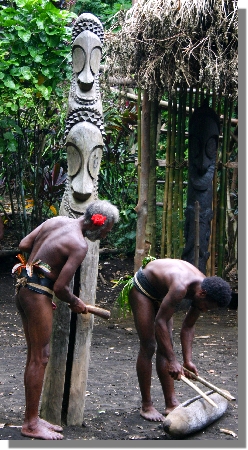
WOW, WOW, WOW
We had no idea just how much new culture and customs we were in for when we headed toward the marvelous islands of Vanuatu. 6 different provinces hold 83 different islands lying directly on top of the Pacific Ring of Fire. This makes it a hot spot, literally, for it's nine active volcano's, seven above ground and two under the water. Combine that with the it's rich history of a Condominium Government in which the British and French had dual control and it's involvement as a prime base during WWII for the United States, there is no lack of things to see and do. Best of all though is the colorful, friendly and most genuine souls we have met yet. Each island is so different from the next. Although missionaries and western civilization have definitely made their mark, the traditions and cultures of their past are readily visible and holding strong. Thank goodness though that acts of cannibalism finally ended in 1969! |
|
 |
|
 |
Port Resolution Bay
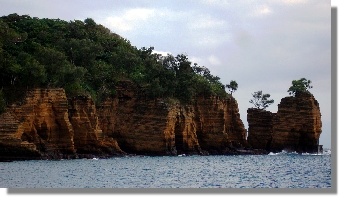
|
|
Our first sight of Vanuatu Islands, the colorful cliffs of Port Resolution on the most southern island of Tanna. Around the edges of the bay we could see seen steam vents, a taste of what was to come. Mt. Yasur, the most accessible and very active volcano. We took a rambunctious truck ride to the edge of the volcano where we witnessed it's bubbling lava. Very surreal. We were all mesmerized as we continued to watch until the sun went down and the red lava glowed in the dark of the night. Large steam clouds would intermittently cover the crater opening making it difficult to see but you could always hear the rumbling below. When the winds shift the fumes could be stifling. A rare but occasional small explosion of the contents would leave us wondering for a split second if Mt. Yasur was deciding to move from a stage II to a stage III. There is even the worlds only post office box at a volcano, from which we mailed a few post cards.
|
A local man named Olsen was the first to row out in his dugout or outrigger to greet us. He spent a lot of time on our boat filling us in on the lingo, Bislama, and many of their customs or kastoms. Next, a local family invited us into their village to celebrate one of their boys first birthday. They provided a beautiful spread of woven mats, plates made from woven palm leaves and decorated with flowers. We gave fresh baked cakes, bread, balloons, marbles for party favors and even brought along our small printer to give them some instant photos of the day. We tasted our first laplap, began our education on the many different cultures of Vanuatu and made some new friends.
Olsen
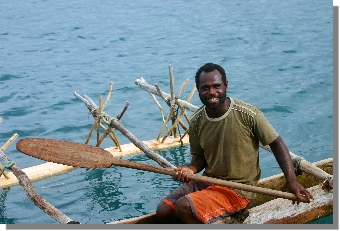
View the photo gallery for Tanna
Bislama is a combination of phonetic English, French and their own words. In addition to speaking Bislama, English and French, there are over 105 different dialects spoken through out this islands. On this island alone they speak 40+ different languages since villages and islands were at one time so isolated from each other. Today they are a bit more connected with twice weekly deliveries from the supply ship the Southern Star.
|
|
Erromango
|
|
The next island up the chain was Erromango. Dillon's Bay sits at the opening of the fresh water, Williams River, that cuts half through the island. It is named of course for the missionary that tried to start Christianity here and then of course was eaten. Here we were instantly greeted by David and Oliver in a bright red outrigger, who promptly began their trading bargains with us and invited us to shore the next day for a tour.
The tour led us up river, through jungles of gardens of every fruit imaginable including kauri and sandalwood trees, one of their exports. Up river they are also able to pump fresh water into their village. Down river are the swimming holes and a large spread of river rocks where the villagers could be seen doing their laundry. We met the chief "Willie" who was insistent that he didn't want us to feel "hassled" by the locals.
At the local school we were greeted by swarms of kids at recess, eager to show us their work. We were impressed. The room was adorned with beautiful art work and environmental awareness as a great theme. With Ms. Marianne's class, we all gathered around a blow up globe and showed where we were from and the route we took to get there.
|
Our tour with David led to an invitation to dinner at his house and a wonderful evening of sharing stories about each of our lives and tasting what would be the best laplap of all Vanuatu. It was dark when we arrived for dinner thereby eating only by the light of a single kerosene lamp. It wasn't until we looked at our photos the next day that we were able to see just how colorful and decorated the interior of his house was.As always, we left this island with a woven basket full of fresh fruit and some new friends. If anyone is interested in some entrepreneurial ventures in Vanuatu, David would like to speak with you and we have his address to connect you.
|
|
|
Efate
|
The island of Efate is home to Port Villa, their capitol, the largest and most industrious town in Vanuatu. Filled with many resorts and shops it was a quick stop for us to do some provisioning and paper work. It was also here that we found ourselves in a local nakamal (bar of sorts) trying our first, and most likely only, kava. We came upon a marvelous man named Kenzie who became our host for the evening. Leading us to a very dark and muddy place covered with blue tarps, sounds of a local string band, he introduced us to the art and kastom of kava drinking. You have to learn to listen to your kava speaking to you as they told us. We will say that it spoke to us and said "I am an acquired taste!", but thanks to Kenzie and Edmund a marvelous experience.
|
The other amazing find here was their open air market. Like many others we had visited throughout the island, it was full of all sorts of delights. Some new ones to us were tasty narli-nuts or "island chestnuts", and nangae nuts, similar to an almond but they come out of an oval fruit that looks like a very large unripe green plumb. Very labor intensive but for the 100 vatu a string (approx. $1 USD), we considered it worth it any time we walked by. They also had little stalls set up within the market where you could pick up a delicious plate of stir fry enough to feed 2 people for a mere 300 vatu's. Most interesting was to find out that this market was open 24 hours day. We came back upon it after our kava outing late one night to find these poor women and stall owners asleep on their woven mats and concrete floors.
|
|
Epi
|
|
We went to Epi in search of dugongs (manatee type animals with a whale tail) and found them along with so much more. On shore we met Kenneth, a pastor and our guide for the day. He gave us a tour from one end of town to the other, including the bakery, the airport and the most impressive boarding school that we had seen yet. It was clear to see what a great importance they placed on education.
The day that we anchored there, the death of an elder had occurred on the little island of Lamen which sits in Lamen bay adjacent to the island of Epi. At sunset, scores of dugouts were seen sailing and rowing from the main island to go and pay their respects.
|
Our final day there just before pulling anchor we spotted the dugong surfacing occasionally as he ate grasses in the bay. The boys gathered their snorkel gear and had the rare chance to watch it swim around below them. The squeals of excitement through their snorkel and large eyeballs make this one of our favorite memories.
|
|
Ambrym |
The island of Ambrym is home to two more of Vanuatu's volcano's, Mt. Benbow and Mt. Marum. and considered Vanuatu's sorcery center. More than a few locals we met throughout the islands had mentioned trips to Ambrym to receive potions or spells to help them in various ways. We luckily timed our visit here with the winds in the coming from the right direction keeping the steam and ash blowing away from the anchorage. Though we didn't make the 4 hour each way trek to visit these beauties, it was still a treat to see them glow red crowns through their steam when the sun went down.
Assisted by Australian volunteer groups, the town of Ranon has set up a lovely visitor center complete with a wide range of activities. We were in search of Rom Dancers in the town of Fanla. Our guide Able led us up hills and through lush jungles to the only village where this type of dance is performed.
The story of the dance being that a maiden once made the costume to win the love of a man. Upon showing how she made the costume to others though he killed her. Today only men can make the costumes after paying for nasara (ability to enter the chief's private area) and as part of their maghe (grade taking ceremony).
|
|
The villages are also known for their arts and musical instruments. Carvings of every kind from black tree fern tamake which look like larger than life tiki men, war clubs, walking sticks, tamtams (slit gong drums) which can stand 3-4 meters high with designs specific to different tribes or families, and bamboo flutes. Carved stones often associated with magic are found as well. We had the chance to watch an elder practice the art of sand drawing by tracing and retracing without ever lifting a finger. There are 180 different intricate designs depicting different pictures of flora, fauna and legends.
|
Malekula
|
Done after a day at the garden
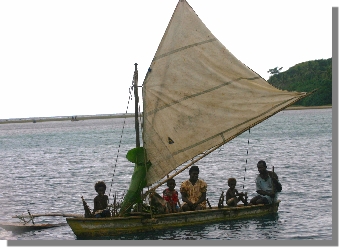
View the photo gallery for Malekula
One of many families heading back to the main island after a day of tending their gardens in the fertile soil of these volcanic islands.
|
We found ourselves at the southern end of Malekula tucked behind the little island of Awai. We had heard there were "magic rocks" here and we were on the hunt. The legend states that if you hit these magic blue rocks together at night you will see blue sparks, which will then bring about blue lights in the sky (lightning) and thunderous storms. At low tide we went hunting and we found them. Oodles of beautiful blue and white quartz stones mixed in amongst the shells and rocks of the hills. And yes they do make sparks, but no, thankfully we did not entice the storm spirits into action that night.
It was here also that some clever locals tried to con us out of a few dollars by claiming that we needed to pay a fee to anchor. We agreed to meet with and pay the chief of that island only to find that the said proprietors didn't live on this island. The chief however who did live there, Marse, was the dearest man whom we could have met, generous and kind.
|
|
A few of our favorite things
Coconut, pamplemousse, ginger and mountain apples.
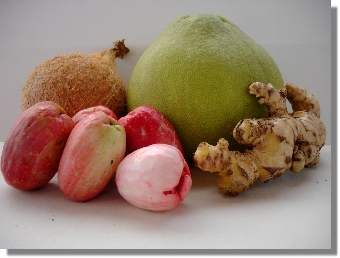
View the photo gallery for Espiritu Santo
|
|
Unfortunately Luganville on the island of Espritiu Santo was to be out last stop in Vanuatu. We were running out of time and there were so many islands and adventures left to be explored. Here we stopped to complete our paper work, do some laundry and provision before our 11 day crossing of the Coral Sea.
Luganville has a rich history for having been built up as an Allies base during WWII, leaving behind today many reminders such as the sunken wreck of the USS President Coolidge and Million dollar point.
We found one last new fruit at the market here, mountain apples. Pictured on the left, these little red fruits are as fragrant as roses and have a taste and texture of a pear. We loaded up on some of our favorites, took a quick tour through town and were on our way.
|
Sad to leave, we were too late in the season to view the famed land diving or naghol on the island of Pentecost, among many other treats. We'll have to catch them all next time around.
|
|
|
|
 |
|
|







